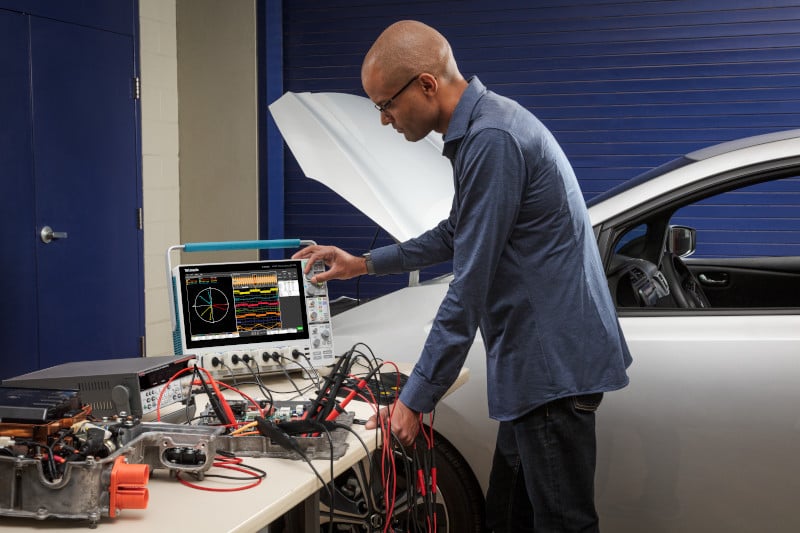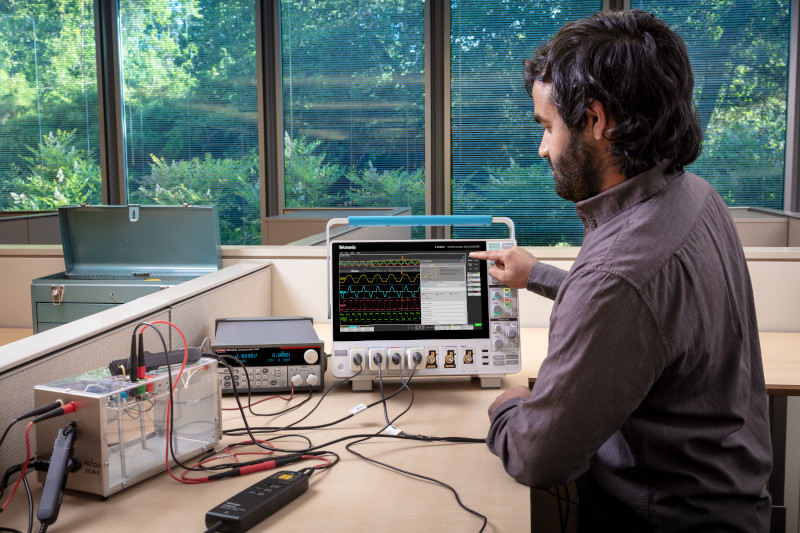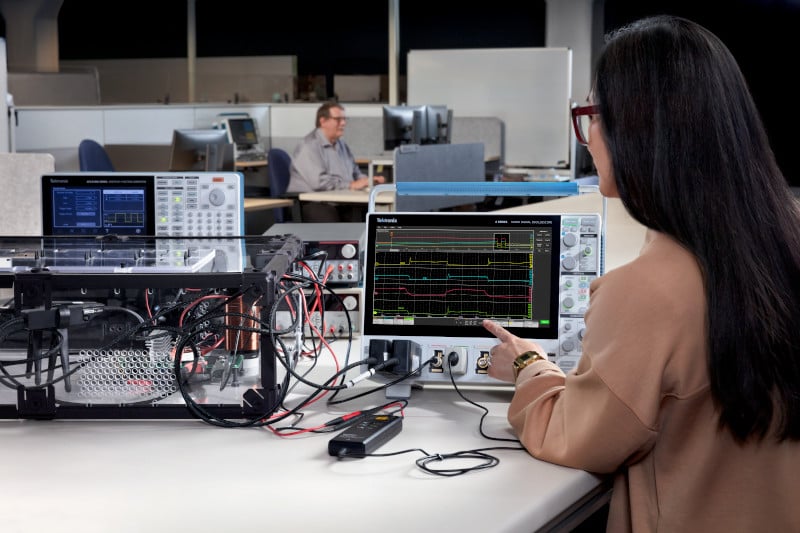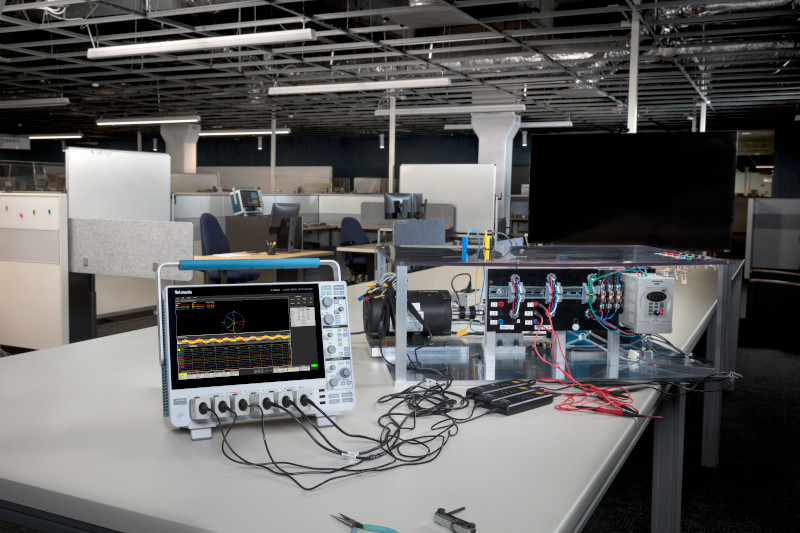Bringing More Power Analysis Tools to Engineers’ Benches with the 4 Series B MSO

It can be challenging to consistently measure the performance of AC-DC and DC-DC converters. These challenges have become even greater as designers work to transition from silicon-based power converters to wide bandgap semiconductors such as silicon carbide (SiC) and gallium nitride (GaN). Designers of 3-phase systems such as motor drives face additional complexity.
Thankfully, help is available in the form of the latest bench oscilloscopes that add processing power and speed for analyzing power supplies and motor drives. Software on these oscilloscopes enables engineers to achieve faster and more repeatable measurements.
An oscilloscope from Tek with more to offer
One such oscilloscope is the Tektronix 4 Series B MSO, with a more powerful processor to speed up analysis for power converter designers. The new user interface is twice as responsive and measurements are significantly faster than the previous generation scope. And it won’t break the bank; the price is affordable for many professional designers.
AC-DC and DC-DC power supply measurements
An option on the oscilloscope can automate key power measurements. The Advanced Power Measurement & Analysis (4-PWR) option can measure AC line inputs for frequency, RMS voltage and current, and crest factor for voltage and current. It also measures true, reactive and apparent power, as well as power factor and phase.

Power Measurement and Analysis software automatically performs calculations to measure switching loss in power converters.
Engineers must make incremental changes to find very small improvements, and this is where measurements such as switching loss and magnetic loss come in. The software also allows the in-circuit measurement of safe operating area for switching devices. All of these measurements are expedited by the 4 Series B’s faster processor.
Moving to wide bandgap devices
For wide bandgap SiC and GaN devices, accurate assessment of switching requires much higher measurement bandwidth to accommodate higher slew rates. Until recently, switching measurements on the high side of half-bridge switching stages relative to the switching node suffered from distortion. This was due to the high common mode voltage signals impinging on the differential signal.
However, the 4 Series B MSO is compatible with a relatively new class of probes that uses optical isolation to achieve common mode rejection ratio (CMRR) of 80 dB at 1 GHz and even higher CMRR at lower frequencies. These IsoVu optically isolated probes can allow measurement of switching signals of 100 V/ns or faster, while avoiding the distortion problem caused by common mode voltage swings.

Double pulse testing is commonly used to evaluate the performance of FETs and IGBTs in-circuit, under conditions that approximate operation at full output or beyond
Analysis software for double pulse testing can help designers make the transition to wide bandgap switching technology. The processing power in the instrument can automate setups, measurements and calculations, making it quicker and easier for designers to measure switching parameters and diode reverse recovery characteristics.
Three-phase power and motor drives
Modern motor drive systems usually use pulse width modulation (PWM) to control the frequency and therefore the speed of a motor, but the changing frequency can cause difficulties in making stable measurements on these signals. Manually determining the right combination of filters and triggers to achieve stable waveforms is tricky, yet necessary, to achieve consistent measurements. Drive systems often have three-phase outputs that complicate connections and setups.
In addition to measuring the output of the drive, measurements to evaluate the performance of the drive's input stages, such as harmonics, power and power factor are also important.
The higher performance and built-in configuration and analysis features of the 4 Series B make it a good choice for these three-phase measurements, something previously only viable on high-end scopes.
Six channels can help with three phases
The output of motor drives and inverters are often three-wire systems with no neutral conductor. Power in these systems can be accurately measured by using just two voltage and two current channels on oscilloscopes, using the two-wattmeter method.
Two voltage channels and two current channels are needed with the voltage channels connected from phase to phase, with one of the phases acting as a reference.

3-Phase analysis software can help achieve stable measurements on PWM motor drive outputs.
This can be performed with a four-channel oscilloscope. However, the inputs to an industrial variable frequency drive are more likely to use a four-wire system with a neutral conductor. Three wattmeters should be used in this case, a configuration that requires six oscilloscope channels: three for the voltages and three for the currents. Although several oscilloscopes offer eight input channels, the 4 Series B MSO is one of the few professional-grade oscilloscopes with six analogue inputs.
Exploring More: 4 Series B MSO
As with most Tektronix instruments, the 4 Series B has standard communications interfaces such as USB and Ethernet. These interfaces enable remote control and data access, as well as test automation. The before mentioned power measurements can all be automated using a comprehensive and fully-documented set of programming commands.
While automation programs can be written in any environment, such as Matlab, C, C++ or LabVIEW, a recently-introduced set of Python Drivers can further simplify automation. For additional information on the 4 Series B MSO, visit our product page.


